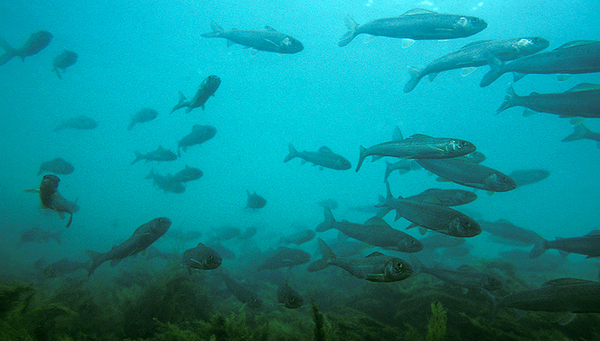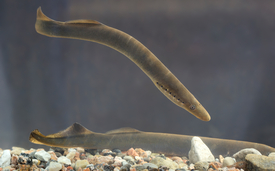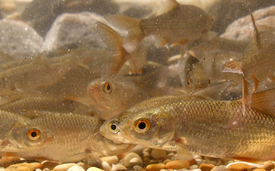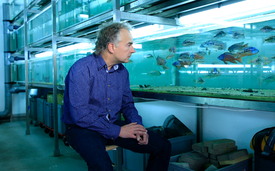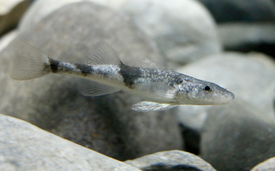News Detail
Unique richness under pressure
March 2, 2023 |
The biodiversity of the Swiss water bodies is unique: 67 native fish and four cyclostomes (fish-like vertebrates) are listed in the Info Fauna reporting system – that is one sixth of the European fish species. This does not even take into account the 35 whitefish species in the lakes bordering the Alps; some of these species have only been discovered in recent years or confirmed as a species in their own right.
The river lamprey (Lampetra fluviatilis) belongs to the cyclostomes. The species is extinct in Switzerland. (Photo: Wikimedia / Tiit Hunt / CC BY-SA 3.0)
New Red List of fish and cyclostomes
But this richness is under threat. The Federal Office for the Environment (FOEN) reports 34 species as endangered in its current Red List of Fish and Cyclostomes. This includes three quarters of the fish that depend on loose gravel for reproduction – and all long-distance migratory species without exception. Other fish species are classified as “potentially endangered” according to the criteria of the International Union for Conservation of Nature (IUCN). A third of the whitefish species documented in 1950 are already extinct. The whitefish was classified at species level for the first time according to the guidelines of the International Union for Conservation of Nature (IUCN).
Overall, the situation in Switzerland has worsened yet again since the last survey in 2007 – and even faster than in neighbouring countries. Nine species are now under so much pressure that they have been given a higher endangerment status than in 2007.
In contrast, a quarter of the species studied are not endangered – for example, the eel (Squalius cephalus) or the roach (Rutilus rutilus), which have less specific habitat requirements. Three species have been found to be increasing in numbers, including the warmth-loving catfish (Silurus glanis).
The roach (Rutilus rutilus) has less specific habitat requirements than other fish species. It is considered to be “not endangered” in Switzerland.
(Photo: Jakob Brodersen, Eawag)
Five questions for Prof. Ole Seehausen
With the systematic inventories of the “Projet Lac” and “Progretto fiumi”, researchers at Eawag and the University of Bern, under direction of Prof. Ole Seehausen, have made a significant contribution to the knowledge of distribution and abundance, especially of species that were little known or unknown until recently.
The numbers sound negative. Are there any developments that make you optimistic?
There is a growing awareness of the complexity of biodiversity and the resulting opportunities and requirements in nature conservation. And with it the willingness to invest time and money in recording and documenting biodiversity and distribution. This is the only way to ultimately identify causes for the decline so that appropriate measures can be taken.
What are the reasons for the decline in fish species and cyclostomes?
The fish habitat is under stress: river straightening, bank stabilisation, altered bank stabilisation, hydropeaking, over-fertilisation and oxygen deficiency are all contributing to this. Other factors are obstacles to migration or movement, climate warming and the displacement of species, which can lead to the displacement of other species and a homogenisation of the species composition.
The Zingel asper, also known as the "Rhone Streber" or “Roi du Doubs”, is threatened with extinction. In Switzerland, the species occurs exclusively in the River Doubs. (Photo: Aquatis)
How rare does a fish species have to become before its decline becomes noticeable in a stream or lake?
It depends on the position of the species in the food web. If the species occurs in high abundance, and especially if it is the dominant or the only species using a certain resource in a habitat, its decline can become apparent very quickly. If, on the other hand, several species use the same resource, the decline of one species may be compensated for by the increase of another species. The presupposes that the other species does not also suffer from the changing factors. This is called the portfolio effect, which is derived from economics. If investments are spread more widely, then the collapse of a sub-market will not immediately have such a negative impact on the overall value of the investments. But as more species disappear, the resilience of a system decreases. And when too many species have disappeared, sudden changes occur that can affect the entire ecosystem.
In recent years, your team has revised the taxonomy of whitefish in Swiss lakes. Whitefish are now included in a separate appendix at species level and no longer only at genus level. What does this change about the overall picture of the Red List?
We are now talking about a total of 100 species (instead of 71) that are considered native. An endangerment status could be determined for 81 (instead of 66). Unfortunately, we then arrive at 18 species already extinct in Switzerland: nine whitefish species listed for the first time and nine of the fish and cyclostomes classified in 2007. Even worse: Because the whitefish species are endemic, i.e. only occur in one or a few neighbouring lakes, these nine extinct species have been lost globally and not just in Switzerland. This also applies to one of the other extinct species – the Jaunet (Salvelinus neocomensis), which was found exclusively in Lake Neuchâtel. With whitefish, we also arrive at a total of 40 endangered and 12 potentially endangered species, as well as 19 with insufficient data. Switzerland has one of the highest extinction rates of freshwater fish in the world.
Whitefish shoal in the Eawag aquarium
A third of the whitefish species (genus Coregonus) documented in 1950 are already extinct. The whitefish was classified at species level for the first time according to the guidelines of the International Union for Conservation of Nature (IUCN). Video: Eawag)
The Chamber of Wonders
The exhibition “Wunderkammer” (or Chamber of Wonders) in the Natural History Museum of Bern provides an insight into current collection activities, modern research methods, but also irreplaceable historical collections. Over 15,000 jars stand on the floor-to-ceiling shelves. Inside them 19,000 objects are stored, including crocodiles, penguins and insects, right up to a collection of eyes. One of the core pieces is the fish collection of Paul Steinmann (1885-1953), a researcher, teacher and president of the Fisheries Association. This collection was stored at Eawag for a long time. Now it serves – newly compiled – as a valuable reference for researchers from all over the world. As of 2010, the collection from the “Projet Lac” also represents a new reference of this kind.
Cover picture: The grayling (Thymallus thymallus) is threatened by climate warming. Its endangerment status varies from “vulnerable” and “strongly endangered” to “threatened with extinction” depending on the populations (Photo: Michel Roggo).

